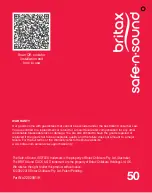
Instructions for Installation & Use
Instructions for Installation & Use
74
75
TRAVELLING TIPS
IN CASE OF CRASH
If your restraint has been involved in a severe crash, you should destroy the restraint
even if no damage is obvious. Some insurance companies offer vehicle insurance which
covers or partially covers the replacement of your child restraint. Contact your insurance
company for further details. Your insurance company may require you to keep the child
restraint for assessment,
but do not use the child restraint after a severe crash.
To assist
you in making an accident insurance claim cut the following statement and include it with
your claim.
All Britax Safe-n-Sound child restraints are manufactured to Australian/New Zealand
Standards AS/NZS1754-2013 which require us to advise users of child restraints to "Destroy
the entire restraint if it has been in use in a severe crash, even if no damage is obvious". The
joint Australian/New Zealand Standards committee CS/85, advise that this statement applies
whether a child was in the child restraint or not. A severe crash, we consider as being one
where the main body structure of the vehicle is distorted.
There is no method of determining if the restraint has been damaged and we concur with the
Australian/New Zealand Standards in recommending destruction of the child restraint.
This notice is to advise you of the requirements of the Australian/New Zealand Standards and
our obligation in complying with the standards.
Please assist the owner of this restraint in their claim.
NOTICE TO INSURANCE COMPANY CHILD
RESTRAINT INVOLVED IN AN ACCIDENT
SAFETY
Never hold a baby in arms when riding in a motor vehicle. In this position the baby could
be thrown against the dashboard, windscreen or other occupant and suffer serious injury
or death.
When riding in a motor vehicle never nurse a baby and use the same seat belt for both
of you. In this position the baby or child could be crushed.
Never breast feed a baby while car is in motion.
Children must be secured in appropriate restraints at all times when the car is in motion.
Children travelling unrestrained and standing up in the car are in danger of serious injury
or death. Traffic regulations in all states require children to be secured in child restraints
or adult seat belts where available.
Plan your trip with frequent comfort stops to reduce stress on babies, young children and
driver. Keep the car well ventilated to reduce heat stress. Car windows should be kept
open to maintain a good flow of fresh air.
Never leave babies or toddlers in a stationary car because of the risk of heat exhaustion.
Ensure babies and toddlers are adequately shaded from direct sunlight through side or
rear windows.
Check the car is ventilated by use of open windows or using the car's ventilation system
taking in external air. Recirculation setting is not suitable for providing ventilation.
Be on guard against carbon monoxide poisoning which can occur through only a slight
leak in the exhaust system while travelling in a closed car.
Securely stow all heavy objects, feeding bottles, etc. that could become missiles during
an accident and cause injury to any occupant.
CLOTHING/BATHING
Since it is often warmer in the car, dress the baby in light clothing.
Do not harness an infant wrapped in a blanket or swaddled. Any blanket or wrap must
only be placed over the harness and infant.
New Zealand Office:
Britax Childcare NZ Limited.
PO Box 100-247 Auckland 9
Telephone: 0508 688 822
Britax Childcare Pty. Ltd.
(Incorporated in Victoria)
A.B.N 55 006 773 600
Head office and registered address:
Level 4, 650 Lorimer Street, Port Melbourne, 3207 VIC
P.O. Box 5119 Garden City VIC 3207
Telephone: 1300 303 330




































